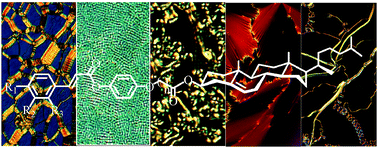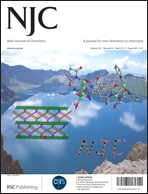Synthesis and thermal behavior of chiral dimers: occurrence of highly frustrated and cholesteric liquid crystal phases†
Abstract
A number of nonsymmetric, optically active, liquid crystal dimers belonging to three different series have been synthesized by condensing cholesteryl ω-(4-hydroxyphenoxy)alkanoates with cinnamic acids bearing mono-, di- and tri-alkoxy tail/s; these are in turn prepared by Knoevenagel condensation of corresponding benzaldehydes with malonic acid. The length and (odd–even) parity of the spacer, which covalently tethers cholesterol and phenyl cinnamate entities, have been varied; the length of the terminal tail, attached to a cinnamate core, has also been varied to understand structure–property correlation. The synthesized compounds have been fully characterized in terms of molecular structure and liquid crystal properties. The vast majority of the dimers exhibit enantiotropic liquid crystal behavior involving mesophases such as chiral nematic (N*), twist grain boundary (TGB) and some unknown mesophases. All the dimers with monoalkoxy tails, except one, display TGB phase possessing chiral smectic C (SmC*) blocks, denoted as the TGBC* phase, over an exceptionally wide thermal range. In fact, in one of the members, the phase occurs for more than 100 °C thermal range, persisting closer to room temperature; this is remarkable, given the fact that such a behavior has been scarcely reported owing to the complex and highly frustrated nature of the TGBC* phase. Compounds with dialkoxy tails and even-parity spacer display N* and/or TGBC* phase/s, where the latter phase exists over a relatively lesser temperature interval when compared to mono-alkoxy materials, but the dimer with dioctyloxy tails exhibits supercooled TGBC* phase up to −60 °C; the analogous dimers with odd-parity spacer display unknown mesophase/s. Trialkoxy-substituted dimers display the N* phase existing over a 30–40 °C thermal range with lower melting and clearing transition temperatures; these features are quite remarkable in view of their various technological applications. The phase transitional behavior shows a dependence on the length and parity of the central spacer as well as the length of the terminal tail. The odd–even effect has been prominently seen in the clearing temperatures, a feature strongly reminiscent to that observed for cholesterol-based dimers reported hitherto.


 Please wait while we load your content...
Please wait while we load your content...